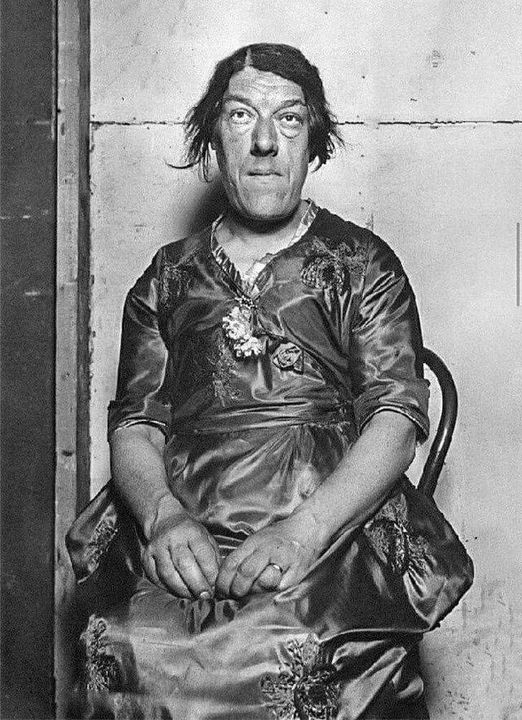Mary Ann Bevan, a charming English woman, was forced to work in early twentieth-century sideshows and circuses after being diagnosed with acromegaly.
Mary Ann Bevan, dubbed the “Ugliest Woman in the World,” frequently performed at carnivals and other such events to make ends meet and provide for her family.
Mary Ann Bevan wasn’t always known for being “ugly.”
She was born in London’s suburbs in the late nineteenth century, and she appeared and was treated like any other young woman.
After reaching maturity and having several children, her life altered when she was afflicted with a rare disfiguring illness.
After only a few years, Bevan’s face, hands, and feet were distorted beyond recognition, forcing her to rely only on her looks to make ends meet.
Mary Ann Bevan, one of the most tragic individuals in the once-thriving sideshow industry, relates the story of how she became the Ugliest Woman in the World.
Mary Ann Bevan’s Early Years
Mary Ann Webster was born to a big family on the suburbs of London on December 20, 1874.
She grew up with her siblings, trained to be a nurse in 1894, and married Thomas Bevan, a farmer from Kent, in 1903.
The Bevans began their marriage with two healthy sons and two healthy girls.
Following Thomas’ tragic death in 1914, Mary was forced to support their four young children on a limited wage.
Following her husband’s death, she began to show signs of acromegaly, a disorder marked by an excess of growth hormone synthesis by the pituitary glands.
Although uncommon, acromegaly may now be successfully treated if detected early.
Bevan’s appearance began to change dramatically, but there was little that could be done due to the medical constraints of the early twentieth century.
Mary Ann Bevan addresses acromegaly and its potential repercussions, including sleep apnea, heart disease, and renal difficulties.
Bevan’s condition caused her normal-sized hands and feet to inflate out of proportion, her forehead and lower jaw to protrude, and her nose to grow significantly.
She had to take on a range of odd jobs to support her family as her looks altered and she struggled to find stable employment.
The unusual condition permanently damaged her look.
A former fairground worker named Bevan said that a farmer she had worked for years before told her that “all [she] was fit for [was] the ugly woman competition.”
Bevan took the farmer’s counsel to heart, and shortly after entered and won the “Homeliest Woman” event, defeating 250 other competitors.
Since her doctor had informed her that her illness would only deteriorate, she decided to take advantage of the circumstance for the sake of her children when her success drew the notice of sideshow owners.
She quickly found constant work performing at fairs around the British Isles.
In 1920, Bevan responded to an advertising in a London newspaper titled “Wanted: Ugliest Woman.” Nothing unpleasant, mutilated, or deformed. Successful applicants will be paid well and have long-term employment opportunities. Send a recent snapshot.
A British representative for Barnum and Bailey’s circus placed the advertisement after discovering that she possessed “what may sound like a paradox, the face of an ugly woman that was not unpleasant.”
Mary Ann Bevan’s Sideshow Success.

Bevan earned around $12 each postcard when she sold them at fairs.
Bevan was invited to participate in the sideshow at Coney Island’s Dreamland amusement park, which was one of the most popular locations for sideshow performers at the time, after submitting the agency a photo he had taken expressly for the event.
Senator William H. Reynolds and sideshow operator Samuel W. Gumpertz, who later collaborated with Harry Houdini, developed the idea for the performance.
She, along with Lionel the Lion-Faced Man, Zip the “Pinhead,” and Jean Carroll the Tattooed Lady, was a popular attraction at carnivals and sideshows.
Visitors to Dreamland were welcome to admire her 154-pound frame, 5-foot-7 height, size 11 feet, and size 25 hands.
Bevan accepted the demeaning treatment in stride. “Smiling mechanically, she offered picture postcards of herself for sale,” earning enough money for herself and her children.
Mary Ann Bevan’s fame expanded over time, and by the 1930s, she was a prominent act in the world-renowned Ringling Bros. and Barnum & Bailey circus.
In only two years of playing in New York, she earned £20,000, which is nearly equivalent to $1.6 million in 2022. This helped her realize her goal of providing for her children.
Mary Ann Bevan’s Final Days
Bevan worked in Coney Island’s Dreamland sideshow until she died in 1933.
Bevan gained friends both in and out of the sideshow world, and he even found time for love. She fell in love with Andrew, the giraffe keeper, while performing at Madison Square Garden in 1929.
She even accepted to get pampered at a New York City salon, where she had a manicure, massage, hair straightening, and face painting.
Some harshly said that “the rouge and powder and the rest were as out of place on Mary Ann’s countenance as lace curtains on the portholes of a dreadnought.” When Mary Ann saw her mirror, she simply stated, “I guess I’ll be getting back to work.”
Bevan spent the rest of her life working at Coney Island until her death on December 26, 1933.
She was 59 years old. Her remains was flown back to England for burial, and she was interred at Brockley and Ladywell Cemetery in the city’s southeast.
Mary Ann Bevan was mostly forgotten by the general public until her image appeared mockingly on a Hallmark card in the early 2000s.
After protests were expressed about exposing her to more humiliation, the card was stopped.
Please SHARE this brave woman with your family and friends!




